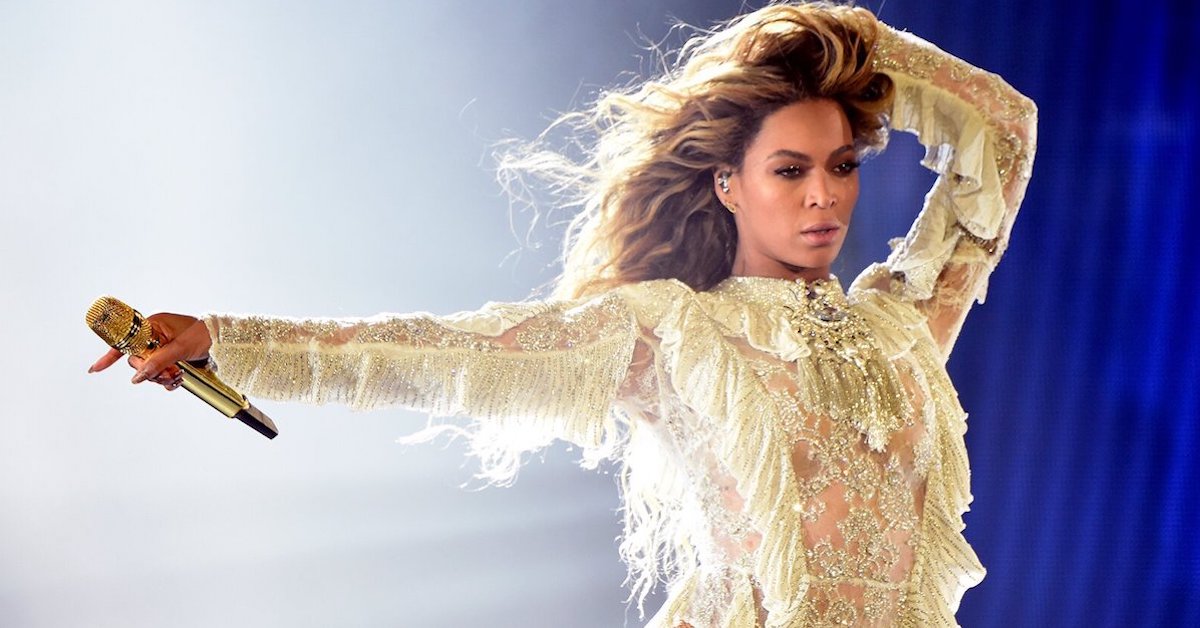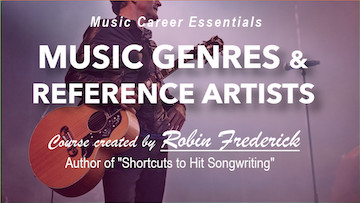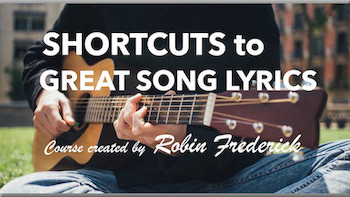Why this song?
“Halo” recorded by Beyoncé is a huge Pop hit that has lasted the test of time and continues to pile up listens at Spotify—over a billion at the time I write this. It’s a great example of a big power ballad with a simple, repeating four-chord progression, a killer melody, and an uplifting lyric.
A lot of songwriters I know love to write songs and lyrics in this style, so let’s see what we can learn from success!
TECHNIQUES TO HEAR AND TRY
• Use lyric images that support your music.
• Employ the power of the octave leap.
• Create a relentlessly hypnotic melody.
• Try a Pop/R&B blend in your production.
Listen to the song. Read the lyrics.
Watch the lyric video on YouTube.
Read the lyric here.
GENRE/STYLE: Pop/R&B
(What is a genre? Watch this video.)
The song “Halo” is great example of a blend of Pop and R&B. The underlying music track by Ryan Tedder is epic Pop. The big kick drum and orchestral strings give this track a dramatic build that sounds more suited to a film score than radio. The instrumental arrangement is reminiscent of the huge ’90s Pop hits of Celine Dion but with a very different, contemporary, rhythmical edge.
The vocal gives the song its R&B flavor. Beyoncé plays with note endings throughout the song and varies the melody between verses, something we often hear in R&B but rarely in Pop. She also manages to add a swing and sway to the vocal that’s lacking in the straight-up Pop track.
This successful mix of styles is achieved by a producer and singer who have mastered their respective genres. If you’re going to blend a two or more styles be sure you know all of them well.
SONG STRUCTURE
This song has a really BIG structure. If you think of some songs as intimate, cozy houses and others as large hotels then this one is a skyscraper. It has a double verse, pre-chorus, a long-ish chorus, and an early example of a post-chorus. No need for a bridge section to add length!
Here’s the song structure:
VERSE / VERSE / PRE-CHORUS / CHORUS / POST-CHORUS
VERSE / VERSE / PRE-CHORUS / CHORUS / POST-CHORUS
CHORUS / POST-CHORUS
VERSE 1a opens with “Remember those walls I built…”
VERSE 1b begins with “I found a way to let you in…”
VERSE 2a starts with “Hit me likea ray of sun…”
VERSE 2b opens with “I swore I’d never fall again…”
CHORUS: “Everywhere I’m looking now …”
POST-CHORUS: “I can feel your halo, halo, halo…”
WHAT IS A POST CHORUS?
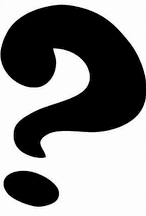
The post-chorus, as its name implies, is a section that follows the chorus. A producer can use it to show off their chops while adding extra hooks—vocal and/or instrumental—to the song.
In this song it provides the opportunity for a big, repeated vocal hook that includes the song’s highest notes and the title image. It’s also the section that most listeners remember.
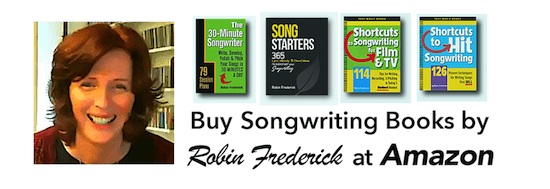
LYRICS
SET THE TONE IN YOUR OPENING LINES
In the opening lines of the song “Halo,” the singer tells us she has a history of shutting love out, but all of her resistance has suddenly vanished.
Remember those walls I built
Well, baby, they’re tumbling down
The singer seems amazed by how easy it was to let go of the past and fall in love. There’s even a hint of the miraculous: the walls “they’re tumbling down” but “they didn’t even make a sound.” This sets up the “angel” and “halo” images as more than just the usual metaphor.
USE THE RIGHT PALETTE OF IMAGES
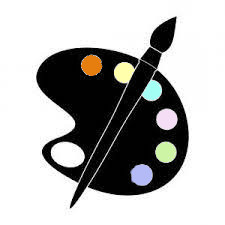
You can compare a palette of lyric images to a painter’s palette. If a painting features delicate pastels, then you won’t find neon orange among the painter’s daubs. On the other hand, if the painting is filled with strong, bold color, then the palette will reflect that.
When a song has a huge, anthemic Pop melody like this one does, the lyric needs to provide imagery that’s a match for the musical power and energy. Here images of light and spirituality appear throughout the lyric, creating a larger-than-life feeling to support that big, uplifting melody.
the light of your halo
ray of sun
burning through my darkest night
I’ve got my angel
It’s like I’ve been awakened
you’re my saving grace
Pray it won’t fade away
– Try It Now –
Write or rewrite a verse and chorus in a song of your own using a palette of images that you feel will support and strengthen the emotion in your melody.
MELODY
EMPLOY THE POWER OF THE OCTAVE LEAP
This song melody is filled with upward leaps in the melody. The first verse features the lowest notes of the song. The pre-chorus note range is about half an octave higher. The chorus ends up a full octave above the verses. The post-chorus reaches the highest notes of all. Large upward leaps like these raise the listener’s energy level in a big way.
Many songs feature a rising note range from verse to pre-chorus to chorus, but this one is exceptionally large. And, while most songs will return to a low, conversational note range for the next verse, this melody doesn’t “reset” at the top of the second verse.
Here the second verse remains an octave above the first one. Beyoncé plays with the melody, gradually descending to the note range of the first pre-chorus. But she never returns all the way to the low notes of Verse 1.
– Try It Now –
Listen to this song and notice the powerful upward motion of the melody beginning with Verse 1 through the post-chorus. Then notice how the melody remains in a higher range for the second verse.
Write a melody that rises a full octave from verse to chorus. You can either jump up a full octave straight from the verse—as Beyoncé does in “If I Were a Boy”— or drop a pre-chorus in between and work your way up. Notice how much emotional energy that octave leap creates!
WRITE A MELODY WITH MOMENTUM

At four minutes and 21 seconds, Beyoncé’s “Halo” is a long song, but it holds the listener’s interest—a pretty amazing feat for a slow ballad (84 BPM).
Much of this is a result of the relentless forward momentum of the melody. It’s so strong it almost creates a sense of vertigo in the listener.
Here are some of the techniques these songwriters used to create that effect.
1.) From the beginning of the song to the end, there are no pauses in the vocal melody longer than one beat. The melody is continually in motion, pulling the listener further into the song.
2.) Every melody phrase in the verse, pre-chorus, and chorus starts on Beat 3 and ends on (or near) Beat 1, constantly leading you from a weaker beat to a stronger one. In the post-chorus, the singer begin a series of short, repeated, overlapping phrases that pick up the pace and start on an even weaker beat, Beat 4.
3.) The melody in every line of the song is rhythmically similar, creating a chant-like feel. The lyrics and note pitches change, but the note rhythm is always a series of short notes followed by one or two LONG ones.
VERSE
Re-mem-ber-those-walls-I BUILT
Well-ba-by-they’re-tumb-l-ing DOWN
PRE-CHORUS
Feels-like-I-ve-been-a-WAKEND
Ev-ry-rule -I-had-you BREAK IT
CHORUS
Ev-ry-where-I’m-look-ing NOW
I’m-sur-roun-ded-by-yo-ur-em BRACE
All together, the rhythmical repetition, rising note range, and lack of pauses give this song its hypnotic, chant-like sound and the feeling that it’s endlessly moving forward.
– Try It Now –
You might not want to create a melody as repetitious as this one. Instead, you can adapt any one of these techniques to create an interesting, contemporary effect in your melody.
TIP: The rising note range, lack of pauses, and creative use of rhythmical note repetition are a hallmark of topline writing. If you’re writing to a repeated four-chord progression like the one in this song, a rising note range is one way you can create contrast between song sections. Varying your note rhythm patterns more than this song does will also help you define your song’s structure.
CHORDS
Beyoncé’s “Halo” consists of four chords and nothing more, it’s that simple. To play along with the recording, capo on the 2nd fret or transpose your keyboard +2.
| G | Amin | Emin | C | – repeat endlessly
Here’s a page on my blog with four-chord progressions you can use in your own songs. Just play and repeat.
PRODUCTION TIPS
VOCALISTS AND NOTE RANGE
The first verse of the song “Halo” is pitched so low that Beyoncé has to really push down to reach the last note of that verse. Obviously the melody has to start low so that the high notes are still in her range. But even with Beyoncé’s enormous vocal range, the lowest note is almost too low. I’m surprised they didn’t change it.
If you’re a singer-songwriter, you get to choose the note range of your song. If it’s too wide for you, don’t be afraid to change the lowest or highest notes. A good melody can survive a few changes.
TIP: Yup, some singers have a phenomenally huge note range while others, who connect just as well with listeners, have very limited pitch ranges.
If you’re going to sing your own songs, be sure you know your comfortable pitch range—the notes you can confidently hit—before writing a song with an octave leap in it.
If you’re hiring a singer, find out his or her note range before recording your track or even commiting to using them. I recommend listening to some of their recordings to verify their pitch range just to be safe.
REVERB CAN TELL THE LISTENER A LOT
Your reverb can communicate information about the environment in which the song exists. Is your singer in a huge hall (like this song) or a tiny, intimate bedroom setting (like Billie Eilish)? Is the drummer or guitar player in the same space as the singer? Is it the right space for the song? Choose your reverbs carefully. The name of the reverb preset will often describe the type of room or hall it evokes.
Be careful about putting your singer and musicians in too many different spaces. Listen carefully to “Halo” and notice how the kick drum, piano, and singer are all in a large hall space.
-Try It Now-
Open up any song file in your DAW and play with reverb. If you’re using a long-tail reverb on a vocal, be sure to dial in some pre-delay to let the singer’s words get started before slathering them in cavernous space.
If you’d like to find out more about the writing and production of this and other tracks by Ryan Tedder, check out this 2013 interview in M Music Magazine.
READ MORE HIT SONG GUIDES ON THIS SITE and learn from the hits!
